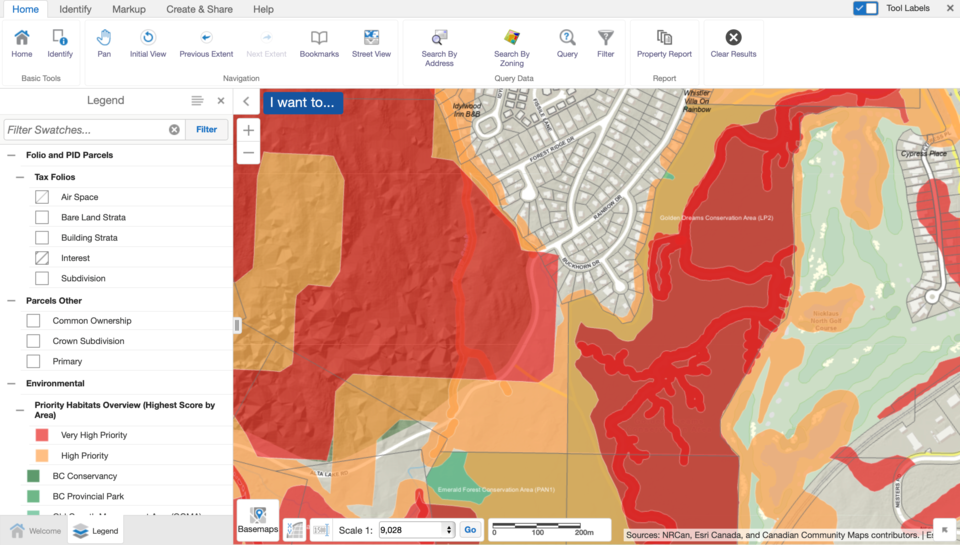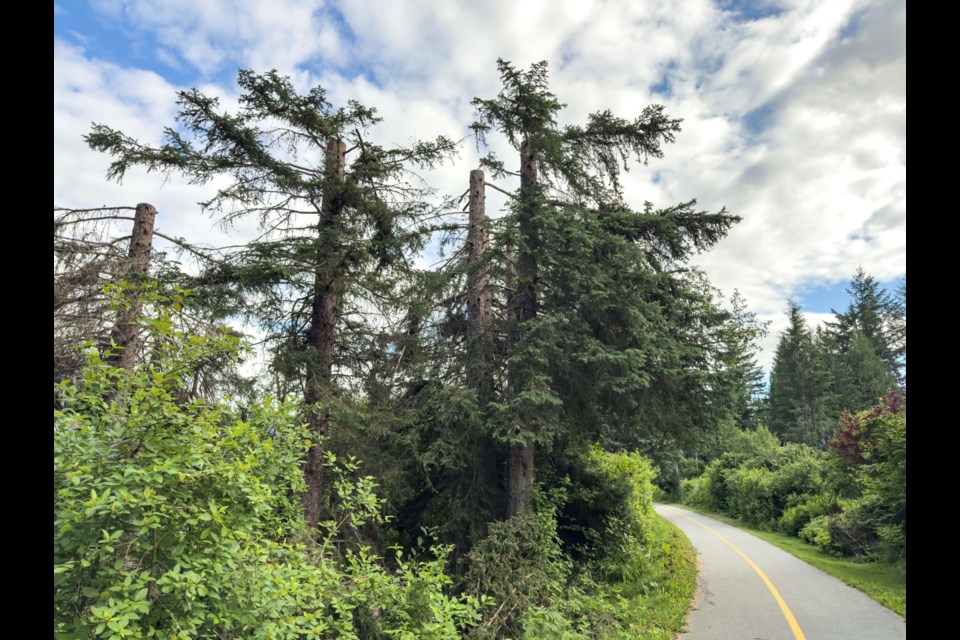In the days leading up to the Resort Municipality of Whistler (RMOW) officially adopting and implementing its new Tree Protection Bylaw, unidentified workers reportedly cut the tops off six spruce trees along the Valley Trail near Buckhorn Pond.
Buckhorn Pond is located near Alpine Meadows, within the Golden Dreams Conservation Area (GDCA), according to publicly available maps provided by the RMOW. The GDCA, a wetland habitat, was described by the municipality in a 2024 Facebook post as “one of Whistler’s largest and most important wetland complexes.” Geographic Information System (GIS) mapping available at webmap.whistler.ca classifies the area as both “very high priority” and “high priority” for environmental protection.

‘Carnage created’
The incident came to light when John Rasmussen, president of local environmental group AWARE, spoke to council on June 24 as the RMOW prepared to adopt the bylaw aimed at regulating tree removal across the municipality.
“Over four consecutive nights in the week commencing 17th of June, a team of workers arrived at approximately 3 a.m. in the morning and proceeded to cut the top two thirds of six [spruce] trees adjacent to the Valley Trail at Buckhorn Drive,” Rasmussen told council. “I personally measured these trees this morning, and all are in excess of 30 centimetres at head height.”
“One can assume that the work of this nature, and the clandestine manner in which it was undertaken, was initiated to improve beauty for a property owner on Buckhorn Drive, and in full knowledge that it was not legal. Interestingly, the site was clear of any ground visible evidence of the carnage created,” he added.
The workers were reportedly captured on a nearby security camera.
While Rasmussen said he doubted the work was done by a licensed arborist from the Sea to Sky region, he emphasized the incident as justification for council to move forward with the bylaw and prevent further unauthorized tree cutting.
Municipality investigating
Whistler Mayor Jack Crompton confirmed the municipality had received a tree-cutting complaint and that bylaw staff were investigating the matter. He said further details could not be released due to privacy concerns.
“Illegal tree cutting is a concern, but the primary reason we passed the bylaw is because it’s good legislation. We’re proud of the bylaw. It took a lot of time and energy and effort and had a lot of input from the community,” he said.
Crompton pointed to the penalties outlined in the bylaw: a $500 fine for cutting trees without a permit, with a maximum fine of $50,000 per tree if the case proceeds to provincial court and results in a conviction. In this case, if prosecuted, the individual responsible could face up to $300,000 in fines.
‘Buzz-cut job’
Cutting the tops off trees—commonly referred to as "topping"—is often done by individuals concerned about tree height, typically near homes or, in this instance, allegedly to improve sightlines from a private residence. But the Arbor Day Foundation strongly advises against the practice.
“It is more than an assault on beauty; it is unnecessary stress and increased risk to the tree’s health. It is also a self-defeating exercise usually not worth the expense, and the results pose a danger from rot and weakly attached re-growth,” the foundation notes in a report available on its website.
Pegah Pourkarimi, executive director of AWARE, said the impacts go far beyond aesthetics.
“I’m presuming [cutting the top off a tree] damages it significantly. Depending on the species of tree, some of them, it could just mean the end. But it's also what other items are impacted by that tree being lopped off at that height—the habitat for the various species, including birds,” she said.
While the loss of habitat is significant, Pourkarimi said the incident also serves as a reminder that trees are essential to human well-being.
“Protecting habitats ensures long-term survival of ecosystems and species that depend on them, but also it ensures our species’ sustainability as well,” she said. “Erosion and flooding are reduced when we keep certain trees intact around certain riparian areas or near the water, and just recognizing their role as far as our own safety is something that just needs to be driven home.”
Beyond the environmental and ecological damage, she added, the visual outcome is also striking.
“If you have a whole bunch of landscapes that look like they’ve had a buzz-cut job, it doesn’t look very good,” Pourkarimi said.




